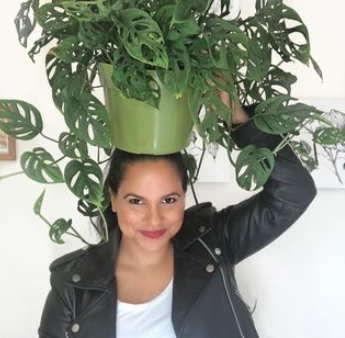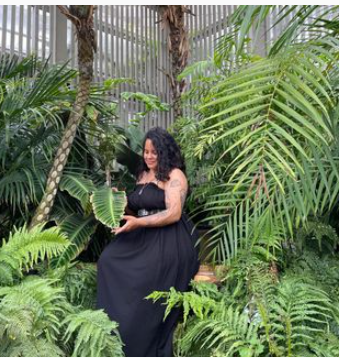Are Rare Plants Real or Are They Just Expensive Plants?
- Latina Jungle Queen

- Oct 8, 2021
- 4 min read
Updated: Jan 30, 2022
There are two schools of thought when it comes to rare plants. The OG collector that's been collecting for years and put forth a great deal of effort to curate their collection. The other is the newbie collector accustomed to seeing so-called "rare plants" at big box stores. They tend to be more skeptical about rare plant collecting.
Denise (pictured above) from @tropicalseductions has been curating her collection for a few years. She’s a collector and an explorer with a large Instagram following. Denise brings some insight into how she feels about rare plants.
Plant The Jungle (Damarys): When did you start collecting plants?
Tropical Seductions (Denise): If we go back to my very first plant purchase, then I would have to say as a child. I loved adding tiny cactuses to my windowsills. My mom usually took on the duty of watering them. It seems I always loved adding green into my life.
Plant The Jungle (Damarys): Have you always been into rare plants? How did you discover rare plants?
Tropical Seductions (Denise): When I started to collect plants I was drawn immediately to tropical plants. I started with a Philodendron green congo. At that time in 2018, I wasn’t aware that there is a world of “Rare Plants”. And then I joined the Plant Community on Instagram and never looked back.
Plant The Jungle (Damarys): Your content and reels are so much fun and really engaging! Some of your best reels are you clapping back when people comment on the retail price of your plants. Do you get a lot of those types of comments?
Tropical Seductions (Denise): It's definitely manageable. Most of the comments are directed towards the market and people use my videos as an outlet to place their frustration on the incredibly high prices that sometimes seem outrageous. Yes, sometimes it is a personal attack and then I feel entitled to delete the comment or even block the account.
Plant The Jungle (Damarys): What are your thoughts on people that say rare plants are just a marketing gimmick to overprice plants?
Tropical Seductions (Denise): Yes, I somewhat agree. There aren’t really many plants truly rare. There are plants that are commercially rare, meaning the demand is higher than the product available. This is obviously not what we mean when using the term “rare”.
Plant The Jungle (Damarys): You’ve visited a lot of rare plants shops, nurseries, and greenhouses. What surprised you the most when you visited these places for the first time?
Tropical Seductions (Denise): The sheer amount of plants available surprised me. There isn’t a plant shortage and plants are grown, propagated, and tissue cultured in mass.

Plant The Jungle (Damarys) Having created the first rare plant collection for big box stores, the program was intended to bring rare plants to mass-markets. Once these rare plants become massed produced, indeed, they are no longer rare as Denise mentioned.
However, just because you can find a plant at your local nursery doesn't mean it's not rare. Most local nurseries aren't purchasing in scale. Rare plants tend to be more expensive locally because they may be challenging to grow or take longer to produce. They may also be challenging to source for smaller growers; it is more costly when starter material is purchased in small quantities. Larger growers have access to tissue culture labs making it more affordable and quicker to market. Therefore, larger growers are able to commercialize rare plants in large quantities.
So, what is the definition of rare? Something is rare when it is seldom occurring or found; this could be defined as seldom occurring in your area or uncommon to your part of the world. Rare can also be identified by something unusual in quality or appeal.

Rare plants do exist! There are rare plant conservatories and conservationists all over the world. Fairchild Botanical Garden in Miami has one of the best aroid rare plant conservatories I've visited. I was also invited to attend their Million Orchid Project earlier this year which focuses on rare orchids.
I had a chance to talk with Dr. Carle E. Lewis (pictured above) in charge of The Million Orchid Project. He informed me that they are working to re-introduce rare and endangered orchids into South Florida's urban landscape.
During the last decade, South Florida used to be an orchid paradise, orchids could be found hanging off every tree branch. In the late 1800s, as the Florida East Coast Railroad extended south, orchids were among the first to be exploited, poached, and commercialized.
Dr. Carle E. Lewis, in charge of The Million Orchid Project, informed me that to date, they have been able to reintroduce almost half a million orchids!
I also met and plan to collaborate with Pablo Garcia Brenes (pictured above), a rare plant conservationist from Wild Tropicals in Costa Rica. Pablo and Cristel Miranda (pictured above) Monestel, their breeder, are focused on conserving rare plants endemic to Costa Rica. Thus far, they have identified 280 rare plant species with market potential.
Globalization, commercialization, and the rare plant craze have allowed many of us to enjoy rare plants from across the world. The quest to discover new species is ongoing and insatiable for some. This is why partnering with Wild Tropicals is essential; while they focus on identifying rare plants endemic to Costa Rica, their core value is sustainability and preservation.
I will personally be traveling back to Colombia in November. Colombia is well known as one of the most aroid-rich countries in the world. They have identified over 500 species, making it one of my favorite places to visit to discover rare plants.











Great read! thank you for posting and informing us on "rare" plants.